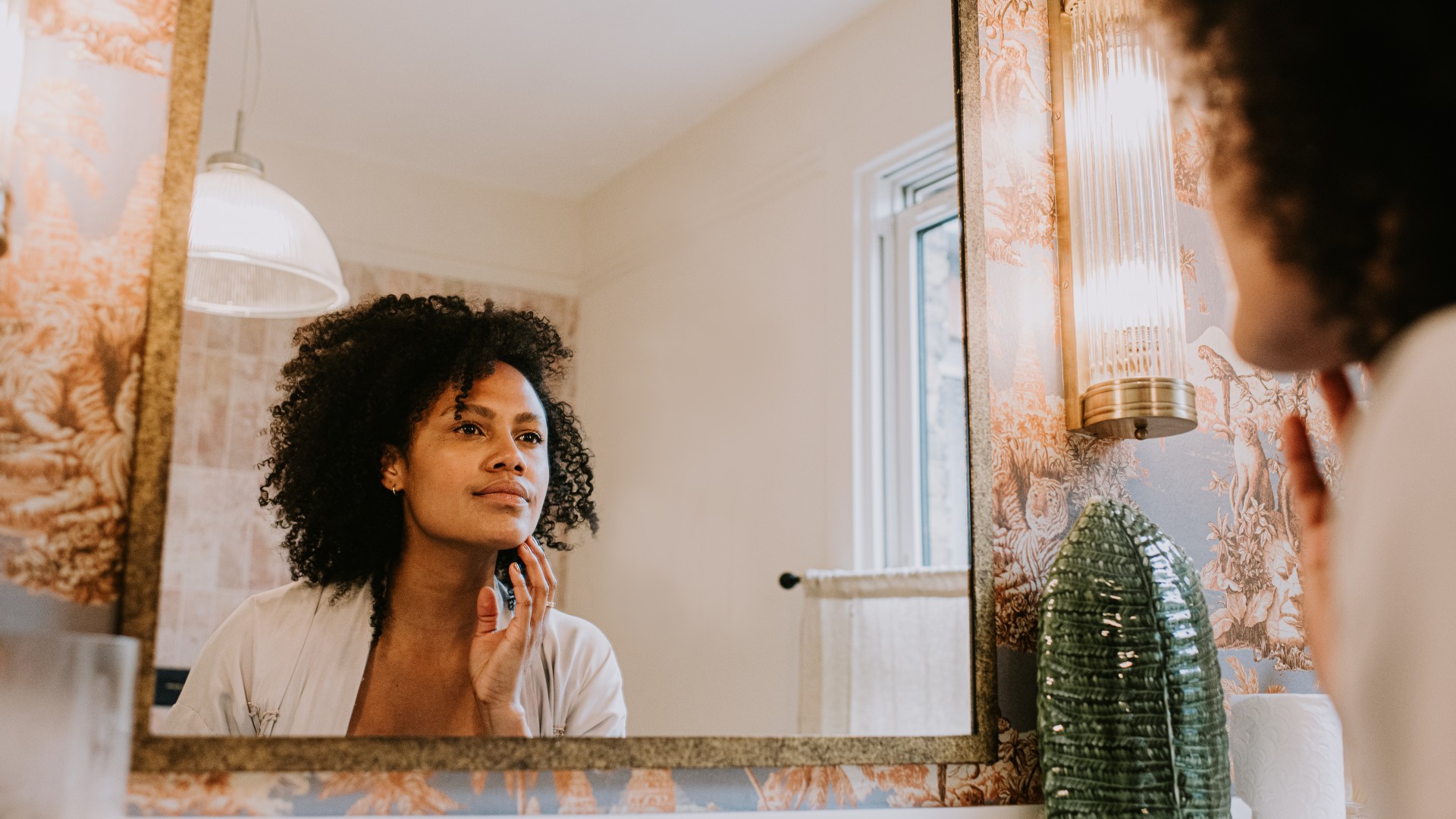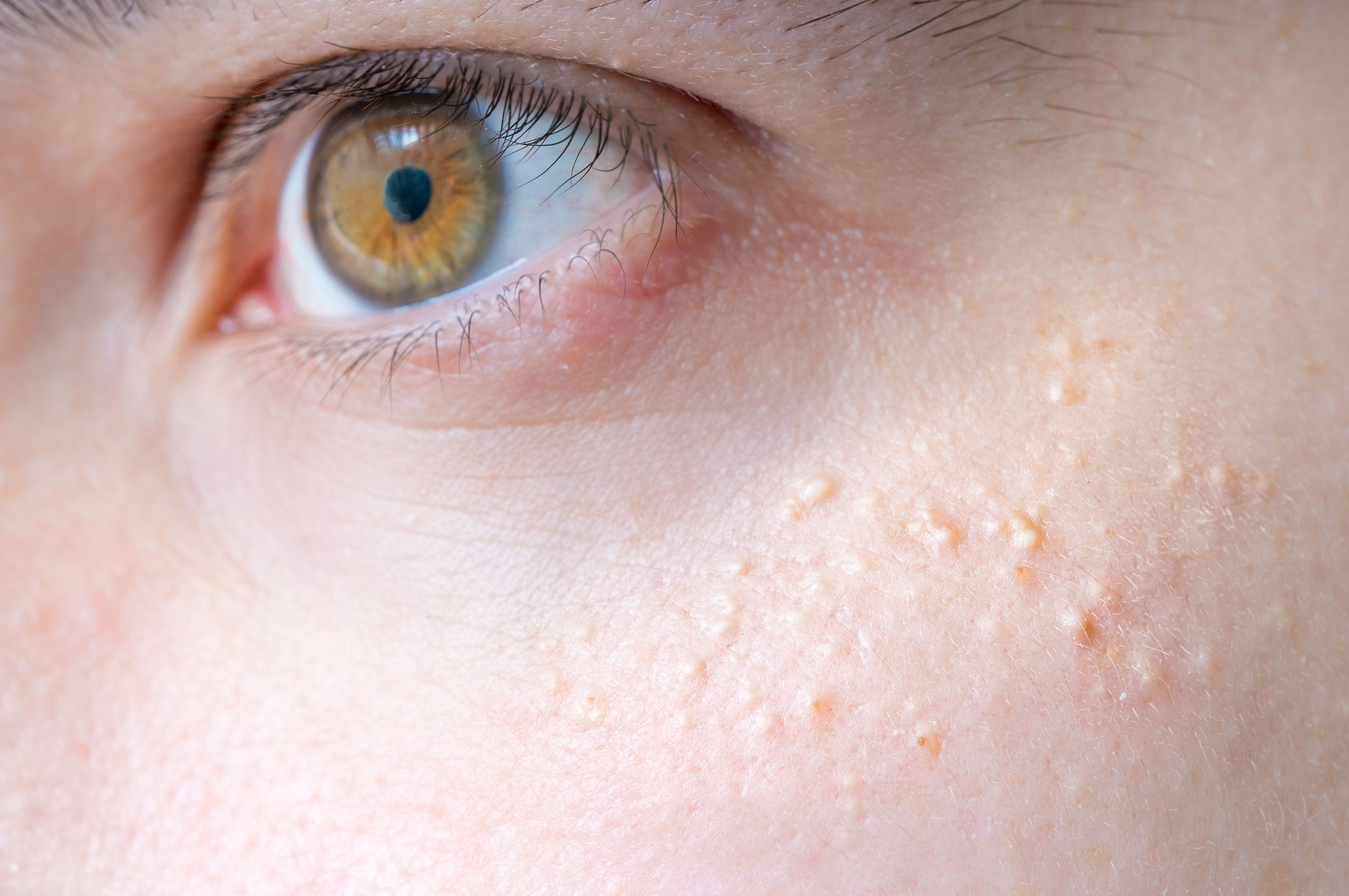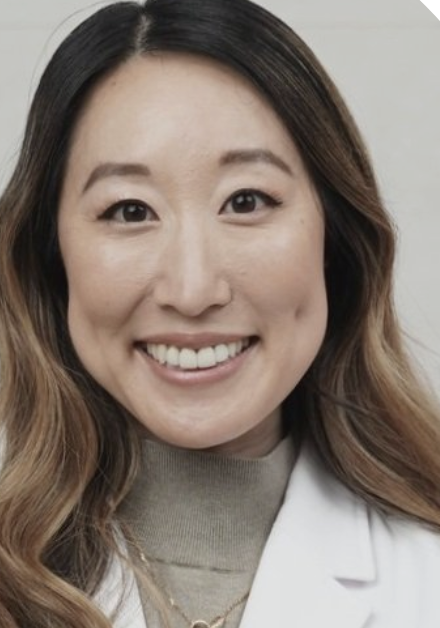How to Prevent (and Treat) Milia, a.k.a Those White Dots on Your Face
Whatever you do: Don’t pop them.


You thought you had a pimple. It was small. Kind of flesh colored, kind of white. But it was really little, rock solid, and no matter how much pressure you applied, pus was missing in action. Sound familiar? Chances are, you were dealing with milia. “Milia are small, white keratin cysts that form in the skin, commonly around the eyes, forehead, and cheeks,” notes board-certified dermatologist and Skin Refinery and creator of Tea with MD Dr. Joyce Park. They shouldn’t hurt and aren’t dangerous, but you also might not want a series of ‘em taking up permanent residence on your face.
Now should that be the case, prevention is key. You’ll need a carefully curated skincare routine (retinoids and exfoliants are your friends—occlusives are your foes). Realizing you have milia as you’re reading this? Do. Not. Pop. There are a few steps you can take (including taking a visit to your dermatologist) to safely, effectively, and efficiently get rid of them. For the complete run down on all things milia, keep reading. Top dermatologists are breaking down their top prevention and treatment recommendations, ahead.
First Things First: What Are Milia?
The skin’s outer layer, the epidermis, is predominantly made up of a protein called keratin. That keratin, commonly referred to as keratinocytes, are largely responsible for keeping the skin elastic, strong, and healthy. But occasionally, that keratin gets trapped under the skin—and that’s when milia form, explains Dr. Park. “It becomes a small, white, firm cyst located just under the top layer of the skin,” she says. “There is no pus, but rather a small cystic structure, which differentiates it from acne breakouts.” You won’t find an opening at the tip (like you would a whitehead or blackhead) and they won’t be accompanied by inflammation or irritation.
You’re likely going to deal with milia on your face (think: around the nose, eyes, and cheeks), but they can also pop up on your chest, back, and genital area.

What Causes Milia?
There are two different camps of milia formation. First up? Primary milia. “This occurs when keratin becomes trapped beneath the skin's surface due to the skin not exfoliating properly,” says board-certified dermatologist Dr. Dustin Portela. “This can happen for various reasons, including genetics, use of products containing oils or emollients, skin injury and of course, sun damage.”
There’s also the possibility that you’re dealing with secondary milia, which are caused by an underlying skin condition. According to Dr Portela, they can form following certain dermabrasion procedures or extended use of a steroid cream.
How to Prevent Milia
While milia aren't dangerous and preventing them isn't guaranteed, there are some changes you can make to your skincare routine to reduce your likelihood of developing them.
Get exclusive access to fashion and beauty trends, hot-off-the-press celebrity news, and more.
Establish a Solid Skincare Routine
You’re going to need to use a gentle cleanser, exfoliate two to three times per week (AHAs and BHAs are your friend) and find a great moisturizer—hydrated skin is happy skin. “Well hydrated skin is less prone to milia—dry skin can contribute to the formation of milia,” says Dr. Portela. “Opt for something lightweight and look for ingredients including hyaluronic acid, ceramides, and glycerin that will help to retain skin’s moisture.”
Try a Retinoid
The main cause of milia is a buildup of dead skin cells underneath the epidermis. So naturally, the solution is preventing said dead skin cells from getting trapped in the first place. Enter: Retinoids. “Retinoids promote cell turnover and prevent pores from becoming clogged,” says Dr. Portela. “Retinoid products can be found over the counter, or your dermatologist can prescribe a stronger product if necessary.”
Avoid Occlusives
Heavy-duty hydrators like Vaseline and Aquaphor are amazing—don’t get me wrong. Occlusive skincare is perfect for trapping in moisture. But if milia are a persistent issue, it might be worthwhile to skip out on the extra layer of hydration. “Using occlusive products, especially around the eyes, can put you at a higher risk for developing milia.” Instead, reach for lightweight serums or gel-based eye creams.
How to Treat Milia
“Generally, milia will go away on its own,” says Dr. Portela. You don’t *have* to treat them. They’re not dangerous. They’re not going to cause you harm. Treating them is purely for cosmetic purposes.
Don’t Try to Pop ‘Em
One of the very important, never-to-be-disregarded, cardinal rules of skincare goes as follows: Don’t pop anything. Pimples are the obvious victims of prying fingers, but milia, a.k.a. those little flesh-colored dots that look like pimples, are the real ones to watch. “You risk getting an infection in the skin, and even scarring yourself,” says Dr. Park.
Get an Extraction
Getting rid of milia is one of those absolutely-do-not-attempt-to-this-at-home situations. So if it is bothering you enough to the point where you want it removed, book an appointment with a professional. They will use disinfectant, sterilized tools, and a steady hand to remove the keratin pearl. “We can manually extract milia by causing a small opening in the milia and then using a comedone extractor to squeeze the keratin pearl out,” says Dr. Park. “It’s the most common and fastest method.”
Consider a Chemical Peel
If your at-home chemical exfoliants aren’t cutting it, you may need your dermatologist to provide something stronger. Cut to: Chemical peels, which come in various strengths. “Chemical peels involve applying a solution to the skin that quickly sheds dead cells to help remove the milia and create smooth skin,” says Dr. Portela.
Understand the Importance of Aftercare
Once your milia has been removed, you need to follow the aftercare instructions provided by your dermatologist. They’ll likely differ slightly from doctor to doctor, but here are the highlights: Avoid picking or scratching. Don’t wear makeup over treated areas. And, stay out of the sun.
Meet the Experts

Dustin Portela, DO, is a Board Certified Dermatologist and Dermatologic Surgeon. He is certified through the American Board of Dermatology, the largest national group of board certified dermatologists. Dr. Portela is an Idaho native having grown up in Southeast Idaho. His professional interests include skin cancer surgery and facial reconstruction, skin cancer prevention, complex medical dermatology and wound healing. Dr. Portela has lectured at national dermatology meetings and has published articles in several medical journals. Dr. Portela graduated with an Honors-Bachelor of Science in Zoology from Idaho State University. He received his medical degree at Des Moines University in Des Moines, IA graduating among the top of his class and being recognized with the Award for Excellence in Physiology. Following medical school Dr. Portela completed his internship through Michigan State University at the Oakwood Southshore Hospital. His residency training in Dermatology and Cutaneous Surgery was completed at Michigan State University through the Beaumont Trenton Hospital in Trenton, Michigan, where he also received his training in Mohs micrographic surgery and was recognized with the Excellence in Dermatologic Surgery Award. Dr. Portela’s professional memberships include the American Academy of Dermatology, American Society for Dermatologic Surgery, American Society for Mohs Surgery, and the American Osteopathic College of Dermatology. Dr. Portela enjoys all aspects of dermatology, from skin cancer treatment and post-surgical reconstruction to cosmetic enhancement, as well as the care of both adult and pediatric patients.

Dr. Joyce Park is a board-certified dermatologist based in Washington, founder of Skin Refinery, a virtual dermatology clinic, and a skincare and beauty content creator at Tea with MD. She attended college and medical school at Stanford University, and completed her dermatology residency at NYU. During medical school, she completed the Stanford-NBC News Global Health Media Fellowship, working in the communications office of the World Health Organization in Switzerland and as part of the medical unit at NBC News. She realized the power of traditional and social media for public health education during this year, and she continued exploring this potential as a fellow interning at the ABC News Medical Unit.

Samantha Holender is the Senior Beauty Editor at Marie Claire, where she reports on the best new launches, dives into the science behind skincare, and shares the breakdown on the latest and greatest trends in the beauty space. She's studied up on every ingredient you'll find on INCI list and is constantly in search of the world's glowiest makeup products. She's constantly tracking the biggest nail and hair trends to pop up in the beauty space, going backstage during fashion weeks, tracking celebrity looks, and constantly talking to celebrity hair stylists, nail artists, and makeup artists. Prior to joining the team, she worked as Us Weekly’s Beauty and Style Editor, where she stayed on the pulse of pop culture and broke down celebrity beauty routines, hair transformations, and red carpet looks. Her words have also appeared on Popsugar, Makeup.com, Skincare.com, Delish.com, and Philadelphia Wedding. Samantha also serves as a board member for the American Society of Magazine Editors (ASME). She first joined the organization in 2018, when she worked as an editorial intern at Food Network Magazine and Pioneer Woman Magazine. Samantha has a degree in Journalism and Mass Communications from The George Washington University’s School of Media and Public Affairs. While at GWU, she was a founding member of the school’s HerCampus chapter and served as its President for four years. When she’s not deep in the beauty closet or swatching eyeshadows, you can find her obsessing over Real Housewives and all things Bravo. Keep up with her on Instagram @samholender.